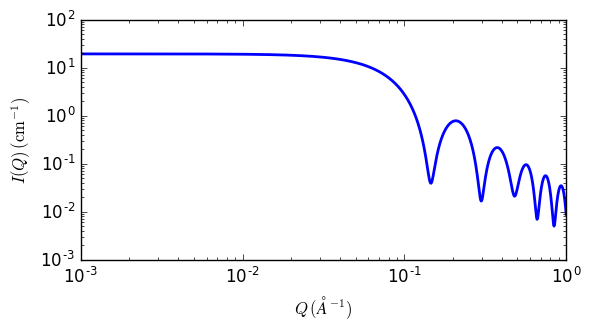hollow_rectangular_prism
Hollow rectangular parallelepiped with uniform scattering length density.
| Parameter | Description | Units | Default value |
|---|---|---|---|
| scale | Source intensity | None | 1 |
| background | Source background | cm-1 | 0.001 |
| sld | Parallelepiped scattering length density | 10-6Å-2 | 6.3 |
| sld_solvent | Solvent scattering length density | 10-6Å-2 | 1 |
| length_a | Shorter side of the parallelepiped | Å | 35 |
| b2a_ratio | Ratio sides b/a | Å | 1 |
| c2a_ratio | Ratio sides c/a | Å | 1 |
| thickness | Thickness of parallelepiped | Å | 1 |
The returned value is scaled to units of cm-1 sr-1, absolute scale.
This model provides the form factor, \(P(q)\), for a hollow rectangular parallelepiped with a wall of thickness \(\Delta\). It computes only the 1D scattering, not the 2D.
Definition
The 1D scattering intensity for this model is calculated by forming the difference of the amplitudes of two massive parallelepipeds differing in their outermost dimensions in each direction by the same length increment \(2\Delta\) (Nayuk, 2012).
As in the case of the massive parallelepiped model (rectangular_prism), the scattering amplitude is computed for a particular orientation of the parallelepiped with respect to the scattering vector and then averaged over all possible orientations, giving
where \(\theta\) is the angle between the \(z\) axis and the longest axis of the parallelepiped, \(\phi\) is the angle between the scattering vector (lying in the \(xy\) plane) and the \(y\) axis, and
where \(A\), \(B\) and \(C\) are the external sides of the parallelepiped fulfilling \(A \le B \le C\), and the volume \(V\) of the parallelepiped is
The 1D scattering intensity is then calculated as
where \(\rho_\text{p}\) is the scattering length of the parallelepiped, \(\rho_\text{solvent}\) is the scattering length of the solvent, and (if the data are in absolute units) scale represents the volume fraction (which is unitless).
The 2D scattering intensity is not computed by this model.
Validation
Validation of the code was conducted by qualitatively comparing the output of the 1D model to the curves shown in (Nayuk, 2012).

Fig. 55 1D plot corresponding to the default parameters of the model.
References
R Nayuk and K Huber, Z. Phys. Chem., 226 (2012) 837-854